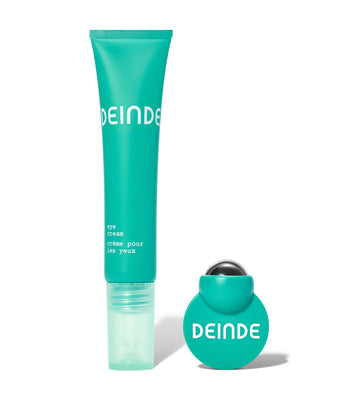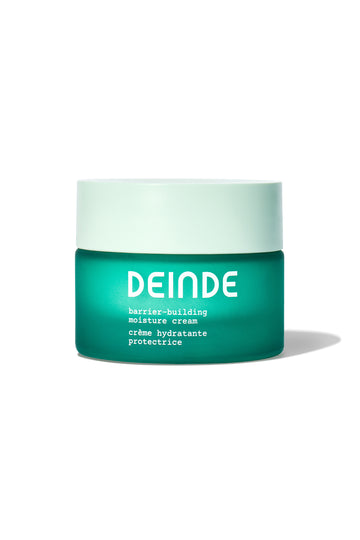
How To Treat Dark Spots on the Face
We all go through rough patches with our skin, where things are a little off-balance. However, there is nothing worse than when that acute period becomes a long-term, historical memory on our faces, reminding us of past wounds.
Enter: dark spots.
Dark spots (also known as hyperpigmentation) can show up on the skin for a variety of reasons. Whether due to sun exposure, hormonal changes, acne scars, or aging, dark spots can be incredibly frustrating and highly visible.
The good news: not only are there numerous treatments available, there are also preventative measures you can take to support your skin’s overall healing response and resilience against external stressors that can cause inflammaging.
We’re here to take you from the dark (spots) into the light.
What’s the deal with hyperpigmentation?
Hyperpigmentation—which can affect all skin types and people of all ages—happens when some parts of the skin produce more melanin (or pigment) that gives the skin its color. When there is excess melanin, spots or patches can appear that are darker than the surrounding skin. Hyperpigmentation occurs when certain areas of the skin produce more melanin, the pigment that gives skin its color. This excess melanin can create spots or patches that appear darker than the surrounding skin, contributing to an uneven skin tone.
What Are the Main Types of Hyperpigmentation?
-
Sunspots (Solar Lentigines): These are flat, brown spots that appear on areas of the skin exposed to the sun, such as the face, hands, and arms. They are commonly seen in older adults, but can occur in younger individuals with significant sun exposure.
-
Post-Inflammatory Hyperpigmentation (PIH) PIH occurs after an inflammatory skin condition like acne, eczema, or injury. The skin responds to inflammation by producing excess melanin, resulting in dark spots.
-
Melasma: This type of hyperpigmentation is often triggered by hormonal changes, such as during pregnancy or from using birth control pills. It typically appears as brown or grayish-brown patches on the face that can be exacerbated by sun exposure.
What causes the appearance of dark spots and hyperpigmentation?
Too much sun exposure.
You guessed it: Ultraviolet (UV) radiation from the sun is one of the primary causes of dark spots on the top layer of skin. You can think about dark spots as the consequence of overstimulating your melanin-producing skin cells (called melanocytes). These cells are stimulated by the UV rays from the sun, which can lead to their overproduction and uneven distribution of pigment throughout the skin.
Dark spots are just one of the many reasons to include a broad-spectrum SPF in your everyday skincare routine—and reapplying consistently throughout the day.
Specific hormonal changes, especially those related to pregnancy.
As mentioned, the brown or grayish-brown patches on the face known as melasma can come about from specific hormonal changes. These changes can be triggered by pregnancy, birth control, and even menopause. It’s important to understand whether dark spots are related to environmental stressors, or whether they are more hormonally based in order to customize your treatment plan.
Injuries to the skin that leave a mark.
As they say… accidents happen. That means you can get dark spots or hyperpigmentation from everyday disruptions to your skin like cuts, burns, or acne. As your skin heals, you may notice dark spots emerging.
Building a strong skin barrier is all about building the resilience in your skin, and ensuring that it knows how to heal well. Although some dark spots are inevitable, it’s important to build your skin’s resilience with everyday skincare so that it can react to unforeseen situations.
The natural course of life, aka aging.
Generally speaking, as we age, our skin’s ability to repair itself slows down, leading to an accumulation of damage and an increased likelihood of developing dark spots and changes in skin color. The aging that our entire body experiences is similar to inflammaging, which is the low level, chronic inflammation that the skin goes through every day.
The best way to help prevent the effects of inflammaging—such as dark spots and hyperpigmentation—is to address inflammaging head-on with everyday skincare. DEINDE’s purifying whipped cleanser, skin-strengthening serum, and moisture-locking face stick each play an important role in diminishing the effects of inflammaging.
How to prevent hyperpigmentation
Stay up on your sun protection.
Preventing sun-induced dark spots starts with diligent UV protection. Here are some easy (and seemingly obvious) ways to do so!:
- Sunscreen: Use a broad-spectrum sunscreen with an SPF of at least 30 daily — which means that, yes, you should even wear sunscreen on cloudy days. Reapply every two hours and after swimming or sweating.
- Protective Clothing: Wear wide-brimmed hats, sunglasses, and long-sleeved clothing to shield your skin from the sun.
- Shade: Seek shade during peak sun hours, typically between 10 a.m. and 4 p.m.
Avoid exacerbating skin trauma.
Your skin will experience some day-to-day stress inevitably. One key component to ensure you are protected against dark spots is allowing your skin time to heal. Minimize the risk of post-inflammatory hyperpigmentation by treating acne promptly and avoiding picking or scratching at your skin.
In other words, don’t pick, pop, pull, or scratch!
What are the best ingredients for managing the look of hyperpigmentation?
There are a variety of skincare-based ingredients that are helpful in managing the look of hyperpigmentation from the outside in. Here are some to look for:
Retinoids
Retinoids, derivatives of vitamin A, can promote skin cell turnover, aid with skin lightening, and help fade the look of dark spots. Topical over-the-counter retinoid products, such as retinol, are effective but may cause skin irritation in some individuals. Start with a lower concentration and gradually increase as your skin adjusts.
Vitamin C
Vitamin C is a potent antioxidant that can help brighten the skin and reduce hyperpigmentation. Look for serums and creams containing stable forms of vitamin C, such as ascorbic acid or sodium ascorbyl phosphate.
Niacinamide
Niacinamide (vitamin B3) is known for its soothing properties and ability to reduce dark spots. It can also help improve skin barrier function. Use niacinamide-containing serums and creams as part of your daily skincare routine. DEINDE’s skin-strengthening serum combines niacinamide with Naringenin (a potent, patented polyphenol) to help reduce the five key signs of inflammaging and support the skin’s natural healing process.
Alpha Hydroxy Acids (AHAs) and Beta Hydroxy Acids (BHAs)
AHAs (such as glycolic acid and lactic acid) and BHAs (such as salicylic acid) exfoliate the skin and promote cell turnover, helping to fade dark spots and get rid of dead skin cells. Incorporate products containing these acids into your skincare routine, starting with lower concentrations and gradually increasing as your skin builds tolerance.
What are some lifestyle considerations for addressing dark spots?
When it comes to antioxidants, go for gold.
As is so often the case, your diet can have a large effect on the health of your skin. When it comes to dark spots and hyperpigmentation, a diet rich in antioxidants, vitamins, and minerals can support your skin barrier’s resilience. If you’re looking to increase the antioxidant levels in your diet, be sure to get plenty of fruits, vegetables, lean proteins, and healthy fats. And specifically blueberries, of course. Always blueberries.
When it comes to skincare, look for antioxidants in the ingredients. For example, Naringenin, which is the leading ingredient in DEINDE’s skin-strengthening serum, is an antioxidant that helps to strengthen skin against daily disruption while sustaining moisture and elasticity.
Stay hydrated… in every capacity.
Staying well-hydrated is essential for maintaining healthy skin. Drink plenty of water throughout the day to keep your skin hydrated and support its natural healing processes. Your skin needs a direct hit of hydration as well.
One easy way to lock in moisture and hydration is to use a daily moisture-locking face stick. DEINDE’s biotech-made formulation helps to sustain firmness, lock in essential moisture, and fortify the skin barrier.
Manage stress.
It’s not easy to do, but it makes a world of difference. Chronic stress can impact your skin’s health and exacerbate hyperpigmentation. (You will probably notice a few other problems when you’re highly stressed as well). If you notice stress is reaching your skin, consider looking into meditation, yoga, or deep breathing exercises.
Get your healthy dose of zzz’s.
Adequate sleep is crucial for skin regeneration and repair. Most experts recommend 7-9 hours of quality sleep each night in order to support your skin’s natural healing processes. Dark spots are all about a failure to fully heal: always try to give your skin the most time and space to heal as you can.
What Is a Good Skincare Routine for Managing Dark Spots?
Healthy Skin Routine
Maintaining a consistent (therefore simple) skincare routine helps to keep the skin healthy and less prone to dark spots. We live for a 3-step routine: Cleanse, Treat, and Moisturize (don’t forget SPF after).
Our skin-fortifying bundle hits all of the high notes when it comes to balancing your skin’s natural barrier, protecting the skin against external stressors, reducing inflammaging, and soothing irritation.
This is how we’d do it…
AM + PM
Cleanse: Our purifying whipped cleanser uses skin-balancing ingredients that gently clean the face without stripping it of its natural oils or compromising its natural microbiome.
Treat: Apply our skin-strengthening serum, which leverages the power of our biotech-formulated potent, patented polyphenol—Naringenin—alongside active ingredient Niacinamide. Together, these active ingredients help to reduce the five key signs of inflammaging (dark spots included!) and support more resilient skin.
Moisturize: Our moisture-locking face stick is the holy grail for soothing irritated skin and keeping your face hydrated on the go. Ingredients like hyaluronic acid, squalane, and—of course—Naringenin instantly calm the skin while protecting it against external stressors looking to wreak havoc.
Protect (AM Only): Finish with a broad-spectrum sunscreen with an SPF of at least 30 to protect your skin from UV damage.
Be patient. Stay consistent.
Like most things in skincare, effective treatment against dark spots tends to come with patience and consistency.
As you adapt new routines, you may notice that it takes weeks or even months for changes to become noticeable—depending on the severity of the hyperpigmentation and the treatment method used. It’s essential to follow your skincare routine diligently and protect your skin from further sun damage to achieve the best results.
Seek out the help of a dermatologist when necessary.
If you have severe or persistent hyperpigmentation (and your everyday tweaks are not just not doing the trick), it’s time to consult a dermatologist. A dermatologist can assess your skin, identify the underlying cause of your dark spots, and recommend the most effective treatments for your specific needs.
Improve your skin’s resilience against everyday stressors.
Dark spots on the face can be frustrating and disappointing, especially for anyone concerned with protecting their skin. One of the best ways to overcome dark spots (or avoid them altogether) is to ensure your everyday skincare routine is building your skin’s resilience against environmental stressors.
By keeping up on your SPF routine, watching your diet, sleep, and stress, you can easily treat dark spots and continue on with radiant, healthy skin.
Sources:
Molecular and histological characterization of age spots | PMC.
Skin Pigmentation Types, Causes and Treatment—A Review | PMC
Hyperpigmentation Therapy: A Review | PMC















